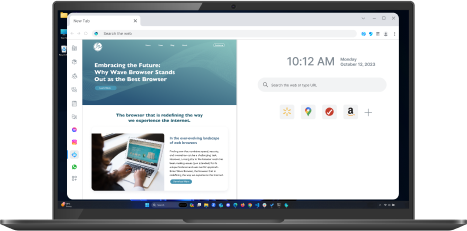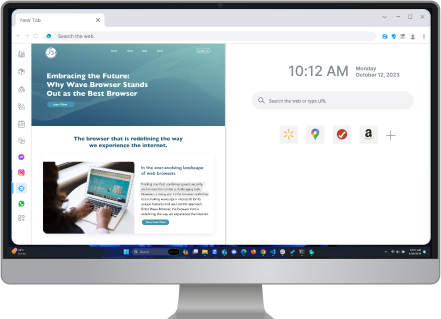WebGL and the Future of Browser Gaming
Table of Contents

In recent years, the landscape of online gaming has undergone a profound transformation, thanks to the advent of WebGL technology. As web browsers like Google Chrome and Microsoft Edge, as well as the gaming browser, continue to evolve, WebGL emerges as a game-changer that promises to shape the future of what it means to have a gamer browser.
In this blog post, we will delve into the role of WebGL, a low-level graphics API, in revolutionizing the gaming experience, exploring its advantages, impact on game development, and how Wave Browser, the best gaming browser, supports and enhances WebGL performance for the ultimate gaming experience.
Understanding WebGL: A Gateway to Immersive Gaming
WebGL, developed by the Khronos Group, is an advanced JavaScript API that enables rendering 3D graphics and interactive visuals directly within a web browser for gamers, like Wave Browser.
By leveraging OpenGL ES shaders (GLSL), WebGL code allows game developers to create sophisticated and visually stunning game content. Unlike its predecessor, Flash, which required plugins and external software, WebGL code harnesses automatic memory management, tapping into a computer's GPU to deliver rich and immersive gaming experiences without any additional installations. As a result, players can dive into captivating 3D worlds, all with just a web browser's address bar as their gateway, without requiring an expensive gaming setup, learning how to improve PC performance for gaming, or a special gamer internet browser.
Transitioning from Flash to WebGL

Over the years, throughout the history of online gaming, the transition to WebGL in online gaming has been nothing short of revolutionary. Before the rise of WebGL API, online gaming predominantly relied on technologies like Flash and Java applets to deliver interactive experiences within even the best browser for gaming. While these technologies served their purpose at the time, they came with limitations, such as the need for external plugins and potential security vulnerabilities.
With the introduction of WebGL, a new era emerged in the world of browser gaming. This cutting-edge technology paved the way for a seamless, plugin-free experience, empowering developers to create sophisticated 3D visuals and interactive content directly within web browsers. As WebGL gained traction, game developers swiftly recognized its potential and began embracing it to create captivating and immersive gaming experiences.
Advantages of WebGL in Gaming

WebGL offers a host of advantages that have propelled it to the forefront of the best web browser for gaming, making it an essential web standard for web applications:
- Seamless Accessibility: By eliminating the need for plugins, WebGL allows gamers to access high-quality, 3D games instantly, without any barriers or compatibility issues across platforms, including Android and iOS.
- Cross-platform Compatibility: Whether you're on a desktop, laptop, or mobile device, WebGL games run smoothly on all major operating systems, making it truly cross-platform and available in browsers like Google Chrome and Android Browser.
- Hardware Acceleration: With direct access to a computer's GPU, WebGL maximizes performance, rendering stunning visuals and complex graphics with efficient use of resources.
- Real-time Interactivity: WebGL enables real-time interactions, making multiplayer gaming and dynamic environments possible within the gaming browser, creating impressive web-based demos.
- Interactive User Experiences: From intuitive controls to responsive interfaces, WebGL empowers developers to create engaging user experiences that keep players immersed and entertained.
The Impact of WebGL on Game Development
With WebGL's rise, game development has taken an innovative turn. Developers, whether established studios or aspiring indie creators, are embracing WebGL to craft groundbreaking browser games that push the boundaries of web-based gaming. Tutorials and demos are readily available, empowering newcomers to learn and explore the world of WebGL game development.
By harnessing the GPU's processing prowess, developers can create visually stunning worlds, complete with lifelike textures, realistic lighting, and dynamic environments. This newfound creative freedom has led to an influx of diverse and engaging games, all developed with open-source WebGL engines, sparking a wave of innovation and creativity in the gaming industry.
What Does WebGL Fluid Mean?

WebGL Fluid refers to a type of interactive graphics demo or simulation built using WebGL technology. In this context, "fluid" refers to the simulation of fluid dynamics, such as water or smoke, within a web browser using WebGL's capabilities to create smooth and realistic animations.
These demos often showcase the real-time rendering power of WebGL, allowing users to interact with and manipulate the fluid simulation directly in their web browsers.
Wave Browser: Taking WebGL Performance to the Next Level

While WebGL provides the foundation for a thrilling gaming experience, the role of top gaming browsers like Wave Browser is paramount in enhancing and supporting the capabilities of video games. Wave Browser is at the forefront of WebGL integration, ensuring speedy rendering and smooth gameplay, making it the best web browser for gamers.
The browser's advanced web technologies optimize WebGL APIs and content creation, while memory management enhances performance, delivering the ultimate gaming journey. As a dedicated gaming browser, Wave Browser incorporates unique features like Memory Saver mode, offering users the ability to prioritize system resources for an optimal gaming experience. With a split-screen made for multitasking, built-in Twitch integration, ad blockers, and fast action buttons, Wave Browser caters to the needs of both casual and serious gamers. Don’t sleep on this incredible gaming browser download—Get Wave Browser today!
How to Enable WebGL on Your Browser

Enabling WebGL on your web browser is a relatively straightforward process. However, it's essential to note that WebGL support depends on the browser version and the hardware capabilities of your device.
Here's a general guide on how to enable WebGL in some of the most commonly used web browsers:
Wave Browser and Other Chromium-based Browsers:
- Open Wave Browser and type Chrome://flags in the address bar, then press Enter.
- In the search bar on the Flags page, type WebGL to find the WebGL-related settings.
- Look for WebGL Settings in Chrome or WebGL 2.0 options and ensure they are set to Enabled.
- Restart your browser to apply the setting changes to your browser.
Mozilla Firefox:
- Open Mozilla Firefox and type about:config in the address bar, then press Enter.
- Click Accept the Risk and Continue to access advanced settings.
- In the search bar on the Config page, type WebGL to find the WebGL-related settings.
- Look for webgl.disabled and webgl.enable-webgl2 options and ensure they are set to true to enable WebGL.
- Restart your browser to apply the changes.
Microsoft Edge:
- Open Microsoft Edge and type edge://flags in the address bar, then press Enter.
- In the search bar on the Experiments page, type WebGL to find the WebGL-related settings.
- Look for WebGL Draft Extensions and WebGL 2.0 options and ensure they are set to Enabled.
- Restart your browser to apply the changes.
Some older devices or web browsers might not support WebGL. In such cases, you will see a message that says Your browser does not support WebGL. If you aren't able to enable WebGL on your browser, you might consider running a WebGL test.
How to Conduct a WebGL Test for Web Browsers

Conducting a WebGL test for your web browser is a valuable practice to ensure that your browser supports and properly implements WebGL functionality. This test not only assesses the browser's capability to render 2D and 3D graphics but also measures the performance of WebGL rendering in terms of frame rates and smoothness.
Step 1: Access WebGL Test Websites
You can access various websites designed specifically for testing WebGL capabilities. Some popular WebGL test websites include:
- WebGL Report: Get an in-depth report on your browser's WebGL capabilities, including supported extensions, maximum texture size, and GPU information.
- WebGL Samples: Find a collection of WebGL demos that test different aspects of WebGL, such as texture mapping, lighting, and particle effects.
- Khronos WebGL Samples: Get a set of official WebGL samples that demonstrate advanced graphics techniques and features.
Step 2: Running the WebGL Demos
Once you have accessed a WebGL test website, you will encounter various demos and interactive simulations. Click on the different demos to run them and observe how your browser handles the WebGL content. The demos should display smoothly and without any significant visual glitches or artifacts.
Step 3: Analyzing the Results
During the WebGL test, pay attention to the following aspects:
- Frame Rate: A smooth frame rate is a key indicator of WebGL performance. The frame rate should remain stable and high, ideally at 60 frames per second (FPS) for a fluid and responsive experience.
- Rendering Quality: The rendering quality should be crisp and visually appealing, without any noticeable visual artifacts or graphical errors.
- Compatibility: Ensure that the WebGL content runs correctly on your browser without any issues or error messages. If you encounter any problems, it may indicate that your browser has limited WebGL support or that there are potential hardware or driver compatibility issues.
Embrace the WebGL Revolution

WebGL is transforming the landscape of browser gaming, delivering stunning visuals, real-time interactions, and unparalleled accessibility. As Wave Browser and other web browsers continue to embrace WebGL and its cutting-edge technology, the future of online gaming holds boundless possibilities.
The world of WebGL fluidly intertwines with web browsers, creating a seamless and immersive gaming experience that captivates players worldwide. So gear up and get ready to experience the boundless possibilities that WebGL, along with Wave Browser and other web browsers, have in store for the ultimate gaming journey.
Surf with Ease, Speed, and Security!

Download Wave Browser for a seamless online experience like never before. Try it now!



























